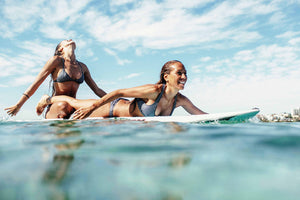Free Shipping For Orders Over $60 Within Australia
Free Shipping For Orders Over $60 Within Australia

In a country like Australia getting protection from the sun is crucial. Everyone knows that ultraviolet rays are no one's friend but when it gets down to the nitty gritty it can be difficult to understand the medical jargon behind UV rays. Here we decode everything you need to know about UV rays so you can protect yourself and your family year round.
UVB
Ultraviolet B rays are what we as Australians are used to protecting ourselves from. UVB rays cause sunburn and a tan and vary in length and potency depending on the time, year and climate. They are stronger in the warmer months which is why you're most likely to get burnt in less time but be wary as the UVB rays bounce off reflective surfaces like the snow and water so you can still get sunburnt in the freezing cold. UVB rays are the most common cause of skin cancer which is why Australia’s sun safety guidelines recommend avoiding the sun around midday when they are the strongest.
UVA
No matter the season, weather or climate ultraviolet A rays are always present. UVA rays are able to penetrate the skin much deeper than UVB rays, therefore causing more damage and are responsible for the skins ageing process. The damage won’t show in a tan or sunburn but more subtly in the form of sunspots and wrinkly, leathery skin up to ten years later.
The bottom line: protect yourself from UVA and UVB rays no matter the season or the weather and never leave the house again without a layer of sunscreen. When choosing sunscreen make it a choice that will protect you, your family and our reefs from nasty chemicals.